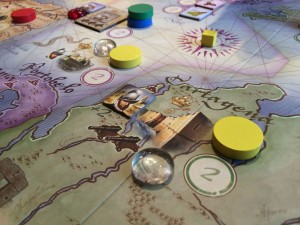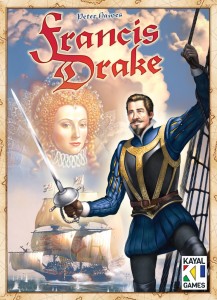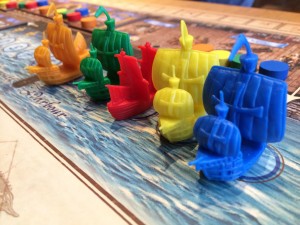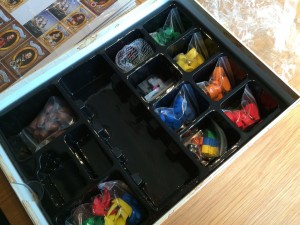Review: Francis Drake
Posted by James (admin) on August 28th, 2014
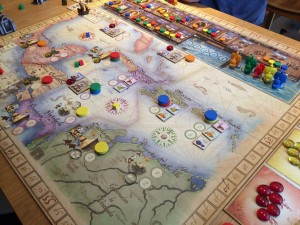 Francis Drake was one of my favourite games at Spiel 2013. A game of sailing, looting and plundering, but with strong eurogame mechanics and some psychological interplay between the players.
Francis Drake was one of my favourite games at Spiel 2013. A game of sailing, looting and plundering, but with strong eurogame mechanics and some psychological interplay between the players.
During the game, players will set sail 3 times and each voyage consists of a provisioning phase and a sailing phase. The provisioning phase is where the players gather resources for their journey: guns, crew, supplies, trade goods, a bigger ship, special roles, etc. Players take turns moving along the main street of Plymouth – 18 locations laid out in a long line – and the players take turns using a location by placing one of their 10 action discs to gain whatever the location offers. However, players can only select locations further down the street from their last location (and never go backwards). Also, some locations have limited slots/uses, plus some of the actions on a location are better than others. As a result, players want to progress slowly to use lots of different locations, but move quickly so they can grab what is on offer before someone else does (and they are potentially left without a resource they want). If you’ve played Egizia (one of my favourite games), you’ll recognise this very engaging game mechanic.
The items you gather are what you will use during your voyage and their combination is very important, so you need to keep re-assessing your plan to make sure your items will work well together and ensure you come out better than your opponents too. For example, the amount of supplies you have limits how far you can travel, having crew and no guns means you could only attack towns, etc.
Once the players have all finished their preparations, they all set sail. On the board are various destinations comprised of towns, forts and galleons which can be attacked, as well as trade ports where players can exchange goods. First, players take turns placing numbered mission discs of their colour face-down next to the destinations they wish to attack (or trade with). Players only know the rough strengths of forts and galleons, and don’t know the numbers on each others’ mission discs either.
After all mission discs are placed, players reveal the disc numbers and resolve each disc in order (all the number 1 discs, then all number 2 discs, etc.) and may attack/trade at the the relevant disc’s location. A player can choose not to attack on their turn because they discover it’s too well defended, they’ve used their resources already, they’ve decided to save their resources for a later action now they know where/when opponents will be acting, etc. Only 2 attacks can be carried out on each destination each round so making an attack can potentially deprive another player from doing so.
To trade, players simply exchange a trade good for one of the location’s exotic goods. To attack, players need crew to attack towns, guns to attack galleons, and crew and guns to attack forts. Successful attacks earn the player victory points (VPs), and the first attack on a destination can earn gold, silver, or gems with bonus VPs too. A player can choose to return to Plymouth rather than resolve any more discs and the first ships back get bonus VPs. Further bonus VPs are also earned for variety in your exploits, but a variety of actions is tricky because that requires a diverse mix of resources.
The game ends after 3 rounds (provisioning and sailing) and there are extra VPs to be earned at game end for having sets of exotic commodities, as well as gold, silver and jewels. The player with the most VPs wins.
Francis Drake has a very interesting mix of game mechanics with the action-claiming play of Egizia in the preparation and then the sailing is a form of worker-placement (but whilst trying to predict other players’ intentions and create the right ordered resolution of your actions). It delivers a lot of elements to consider and balance but all in a very dense/rich experience.
The provisioning phase can often go very differently to your plan. You may look at the board and have an idea of where/what you want to go/do but what other players take often changes your ideas. You may want to attack galleons but find others are taking lots of guns so you need to adjust your plan as you go.
As soon as you sail, you will see which locations other players are able to reach (based on their supplies) and what equipment they have, so you can start to try and figure out their plans, if they may interfere with yours, and how you will try to crush their dreams. I find the the mission disc placement stage very tense because it’s about reading other players’ intentions and getting yours to work better. Seeing someone place a disc at a location you were counting on can be nerve-wracking – have they placed a lower number disc than you? Should you change your plan of which numbered disc will be placed where? etc. Bluffing can also play a part too.
Once the mission discs are placed, you will see the order in which actions will be taken but it’s only when someone makes the first attack on a location that you will know its exact strength, and this can also change your plans if you find you don’t have enough resources to do all that you wanted.
Before each round, the 18 ‘shops’ (tiles) in the street are shuffled so the order they appear in can be very different. This adds some nice variety between rounds and games. As well as resources, the provisions phase can give players some really useful special abilities. For example, you may be able to look at some mission discs and swap two, or place the tiles that add extra strength to the forts or the galleons. Having the ghost ship gives you an extra mission disc without an action – it doesn’t sound very useful, but it lets you bluff more, plus you’ll be the last player to place a mission disc once everyone else have placed theirs. Having the Golden Hind gives you an extra mission disc which acts before any other disc. Plus, there are some other items too.
Each round is separate so players don’t carry any resources (apart from exotic goods) or roles over. Whilst this means there’s no progression (apart from trying to collect sets of exotic goods), it means players who do badly in one round are not penalised further. I did wonder if a player who does badly during a round (few successful missions) could keep one or two resources, so they had a slight edge on the next round to make up for their lack of success; however, this hasn’t been needed in my games.
There do seem to be several strategies to gaining VPs: hit lots of different locations to get the variety bonus VPs, focus on gaining set(s) of trade goods for big VPs at the end, hit locations where bonus gems are located, etc. However, all of these strategies paths need a plan or you’ll gain little.
The game plays 3-5 players and it scales by using specific set of street tiles for the number of players (so the resources available are balanced). The production quality is excellent with sturdy pieces and nice slot-together treasure chests (reminiscent of Merchants & Marauders). Like the designer’s other Spiel 2013 release (Triassic Terror), a special mention has to go to the box inner. Yes, it’s not often the inner gets a mention but the one in Francis Drake has a bespoke plastic tray for all the different elements, and the top edge of the box base has a cut-away section so you can get your finger under the board without having to wedge it down the gap between board and box.
Overall, Francis Drake is an excellent (yet simple), tense and relatively meaty eurogame which contains lots of tricky decisions whilst looking great doing it.
You can read the rules and see the details of the game on Eagle Game’s web site using this link: bga.me/drake
James.


